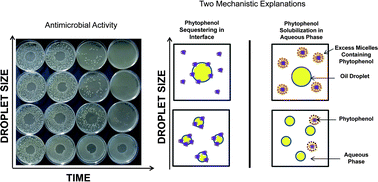In this study we investigated the effect of droplet size on the antimicrobial activity of emulsions containing two essential oil compounds that are known for their antimicrobial effectiveness: carvacrol and eugenol. Coarse emulsions were prepared by blending a triacylglyceride (Miglyol 812N) containing various concentrations of carvacrol or eugenol (5, 15, 30, 50 wt%) at an oil droplet mass fraction of 10 wt% with an aqueous phase containing 2 wt% Tween 80®. Premixes were then further dispersed using a high shear blender, a high pressure homogenizer at different pressures or an ultrasonicator to produce droplets with a variety of mean diameters. Microscopy and light scattering storage stability studies over 10 days indicated that manufactured emulsions were stable, i.e. that no aggregation, creaming or other destabilization mechanisms occurred and droplet size distributions remained unchanged. The antimicrobial activity of emulsions was assessed against two model microorganisms, the Gram negative Escherichia coli C 600 and the Gram positive Listeria innocua, by determining growth over time behavior. The analysis yielded the unexpected result that emulsions with larger droplet sizes were more effective at inhibiting growth and inactivating cells than smaller ones. For example, emulsions with a mean oil droplet size of 3000 nm at a concentration of 800 ppm carvacrol completely inhibited L. innocua, while for 80 nm emulsions, only a delay of growth could be observed. Measurements of the concentration of the antimicrobial compounds in the aqueous phase indicated that concentrations of eugenol and carvacrol decreased with decreasing oil droplet sizes. Determination of interfacial tension further showed that eugenol and carvacrol are preferentially located in the oil–water interfaces. Theoretical calculations of Tween 80® concentrations needed to saturate interfaces suggested that in small emulsions for the given formulation less Tween 80® micelles are present in the aqueous phase. We therefore attribute the fact that antimicrobial nanoemulsions are less active than macroemulsions due to an increased sequestering of antimicrobials in emulsion interfaces and a decreased solubilization in excess Tween 80® micelles.

You have access to this article
 Please wait while we load your content...
Something went wrong. Try again?
Please wait while we load your content...
Something went wrong. Try again?


 Please wait while we load your content...
Please wait while we load your content...